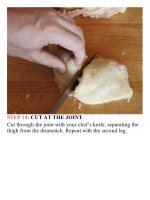The food lab better home cooking through science ( PDFDrive ) 109
Bạn đang xem bản rút gọn của tài liệu. Xem và tải ngay bản đầy đủ của tài liệu tại đây (133.13 KB, 2 trang )
would in the open air. Most pressure cookers allow
you to cook at temperatures between 240° and
250°F, no matter what the altitude. This is why
pressure cookers are so popular throughout the
Andes—no self-respecting Colombian home is
withoutone.
WATER-BOILINGMYTHS
M
ythsaboutboilingwaterabound.Herearefour
ofthemostcommon:
• Cold water comes to a boil faster than hot
water. False. It’s absolutely untrue, but there
is a good reason to use cold water instead of
hot for cooking: hot water will contain more
dissolvedmineralsfromyourpipes,whichcan
giveyourfoodanoffflavor.
•Waterthat’sbeenfrozenorpreviouslyboiled
willcometoaboilfaster. False, though there
is a little scientific reasoning behind this one.
Boiling or freezing water removes dissolved
gases (mostly oxygen), which can slightly
affect the boiling temperature—so slightly, in
fact, that neither my timer nor my
thermometercoulddetectanydifference.
•Saltraisestheboilingpointofwater. True...
sortof.Dissolvedsolidslikesaltandsugarwill
in fact increase the boiling point of water,
causing it to come to a boil more slowly, but
the effect is minimal (the amounts normally
used in cooking effect less than a 1-degree
change). For it to make any significant
difference, you’d need to add it in really vast
quantities. So for the most part, you can
ignorethisone.
• A watched pot never boils. Definitely true.
Avertyoureyes.
OnSaltandNucleation
So, if salt doesn’t lower the boiling point of water,
how come throwing a handful of salt into a
simmering pot will cause a sudden eruption of
bubbles?It’sbecauseoftinythingscallednucleation
sites, which are, essentially, the birthplace of
bubbles.Inorderforbubblesofsteamtoform,there
hastobesomesortofirregularitywithinthevolume
of water—microscopic scratches on the inside
surfaceofthepotwilldo,aswilltinybitsofdustor
the pores of a wooden spoon. A handful of salt
rapidly introduces thousands of nucleation sites,
makingitveryeasyforbubblestoformandescape.
The same principle is used to “seed” clouds.
Releasing dusty particles from an airplane causes
millionsofnucleationsitestobecreatedinthemoist
atmosphere so water vapor droplets can coalesce
andformclouds.









